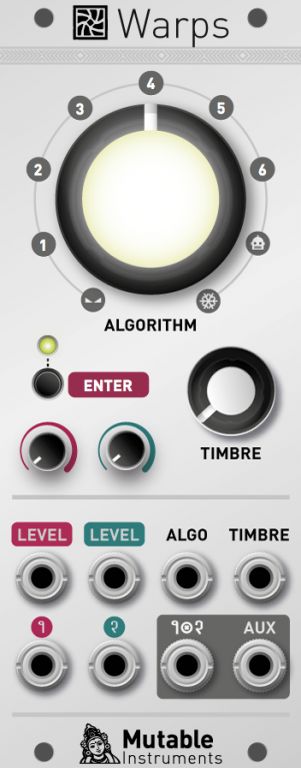Mutable Instruments Warps
Easter egg
https://www.muffwiggler.com/forum/viewtopic.php?p=2063240#2063240
remove any inputs, put the timbre and two level knobs all the way to the left as in Olivier's image, then enter that sequence with the big knob.
1) 2 2) 4 3) 3 4) 6 5) 1 6) 5 7) Die is thrown but caught before it lands
Just dial in these numbers with the big knob and press the button after each number!
Step 1 - The second algorithm symbol looks like a fire (1). Step 2 - Turn on the red light. Step 3 - Fifth algorithm looks like a pizza. (4) Step 4 - Third algorithm looks like a die (Yahtzee) (2).
https://www.muffwiggler.com/forum/viewtopic.php?p=2063918#2063918
pichenettes Veteran Wiggler
Joined: 06 Aug 2012
Last Visit: 27 Nov 2015
[Years of Membership] [Years of Membership] [Years of Membership]
Posts: 613
Location: Paris
PostPosted: Thu Nov 26, 2015 10:40 pm Post subject: Reply with quote Add User to Ignore List Here's a little explanation about the easter egg...
With INT. OSC enabled, the module works as a frequency shifter.
ALGORITHM knob and ALGO CV input: frequency shift. No shifting at 12 o'clock, positive frequencies when turning CW, negative frequencies when turning CCW. The control curve is linear until 50 Hz then becomes exponential. The response of the ALGO CV input (which modulates shifting amount) depends on the position of the big knob - it is linear when the big knob is near its central position, and 1V/Octave-ish when the big knob is above 50 Hz or below -50Hz.
INT. OSC: carrier waveform. Available waveforms: sine, three harmonics, "random" signal created by summing 7 harmonics with random amplitudes/phases. With a low frequency shifting amount, you can think of this as the tremolo/delay/phasing modulation waveform. Another way to think about this parameter is that there will be one shifted "copy" of the input signal per harmonic of the carrier waveform.
LEVEL 1 CV/knob: feedback amount.
LEVEL 2 CV/knob: dry/wet amount.
TIMBRE: balance between the lower and upper sidebands. Both sidebands are present (ring-modulation) when the knob is at 12 o'clock.
AUDIO IN 1 & 2: two audio inputs, summed together.
AUDIO OUT 1+2 / AUX: the two audio outputs react reversely to the TIMBRE knob. For example, if TIMBRE is fully CCW, 1+2 will output the lower sideband, and AUX will output the upper sideband. Great for generating a wide stereo image!
Now what happens when you disable INT. OSC? The module becomes a kind of "quadrature cross-modulator". Mathematically, it computes the product of the analytic signals obtained from inputs 1 and 2, and another complex exponential - then the real and imaginary parts of the result are dispatched to the two outputs. This one is tricky to explain! You can think of it as frequency shifting, except that instead of dialing the shifting frequency with the big knob, you directly feed a sinewave at this frequency on input 1 to shift input 2. Obviously, feeding a waveform more complex than a sinewave on input 1 will cause multiple shifts of the signal on input 2 - creating very complex inharmonic tones! When INT. OSC is disabled, ALGORITHM controls the amount of phase shifting on the result of the modulation. You won't hear much difference when you move it very slowly - the magic happens when it is modulated.
